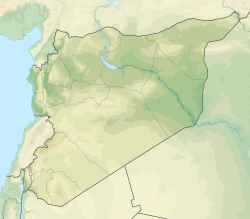Top Qs
Timeline
Chat
Perspective
Tell Taban
Archaeological site in Syria From Wikipedia, the free encyclopedia
Remove ads
Tell Taban is an archaeological site in north-eastern Syria in the Al-Hasakah Governorate, near the Habur river. It is the site of the ancient city of Ṭābatum/Ṭābetu (rarely Ṭabēte).
Remove ads
Archaeology

The site was first excavated by a Kokushikan University Archaeological Mission team led by Hirotoshi Numoto from 1997 until 1999 as a salvage operation in response to the effects of the Hassake dam.[1][2][3] A number of inscribed objects, mostly building inscriptions, were found. The site was again excavated in 2005 through 2010. More inscriptions and an archive containing over 100 cuneiform tablets were found, dating to the Old Babylonian and Middle Assyrian Periods.[4][5][6][7][8]
Remove ads
History
Summarize
Perspective
Middle Bronze Age
The city was mentioned in 18th century BC as a regional center named Ṭābatum in the tablets of the kingdom of Mari, and was destroyed by Samsu-Iluna of Babylon.[9][10] In a text from the time of ruler Zimri-Lim found at Mari an official was sent to Ṭābatum which was being incorporated into the province of Qattunan. He traveled through Saggarâtum and on arriving found that the city had been completely evacuated before some unstated menace.[11] Although it was about 200 kilometers away from Mari it is known the Zimri-Lim maintained a large estate at Ṭābatum.[12] Afterward the city come under the control of the kingdom of Khana centered on Terqa for a time.[13]
Late Bronze Age

A few centuries later Khana was part of the Mitanni Empire. The Fall of Mitanni to Suppiluliuma I in 1345 BC, saw this area come under the Assyrians.
Ṭābetu had an autonomous dynasty ruled the city between the mid 14th and early 12th centuries BC as vassals of the Middle Assyrian kings; the rulers of Ṭābetu styled themselves "the kings of Ṭābetu and the Land of Mari".[14] It is important to note that in this period two places went by the name "Land of Mari", one in the area around Mãri (Tell Hariri) in the Middle Euphrates region and the other in the area around Tell Taban in the Middle Habur region.[15]
By the time of middle-Assyrian period kingdom of Ṭābetu, the designation "Mari" was likely used to indicate the lands around Ṭābetu and did not refer to the ancient kingdom of Mari located on the Euphrates.[16] Another possibility is that Mari from the Ṭābetu king's title correspond to "Marê"; a city mentioned c. 803 BC in the stele of Nergal-ereš, a Limmu of the neo-Assyrian king Adad-nirari III. Marê was mentioned in association with Raṣappu which was likely located in the southern and eastern slopes of the Sinjar Mountains.[17]
It is thought that in this period there was a shrine of the goddess Gula at the site.[18][19]
It has been proposed that there was a temple of Sebettu at the site in this period. During the reign of local ruler Aššur-Ketta-Lešir I a letter found at Tell Taban addressed to one Labeʾtu reads "Let me deliver 1 sūtu of fine oil, which my lady requested. It will enter the temple of the Sebettu, who protects you".[20]
Remove ads
King List
Summarize
Perspective
The origin of the dynasty is vague; the first known two rulers bore Hurrian names.[21] However, "the land of Mari" is mentioned in the Hurrian Mitannian archive of Nuzi, and tablets dating to the 15th and 14th centuries BC from Tell Taban itself reveal that the inhabitants were Amorites.[21] The dynasty could have been Amorite in origin but adopted Hurrian royal names to appease the Mitannian empire.[21] The kings of Ṭābetu seems to have acknowledged the authority of Assyria as soon as the Assyrian conquest of Mitanni began; in return, the Assyrians approved the continuation of the local dynasty whose rulers were quickly Assyrianised and adopted Assyrian names replacing the Hurrian names. This is a list of the kings of Ṭābetu who belonged to the same dynasty.[22]
See also
References
Further reading
Wikiwand - on
Seamless Wikipedia browsing. On steroids.
Remove ads

